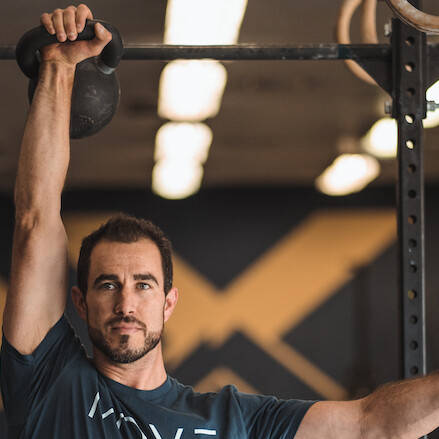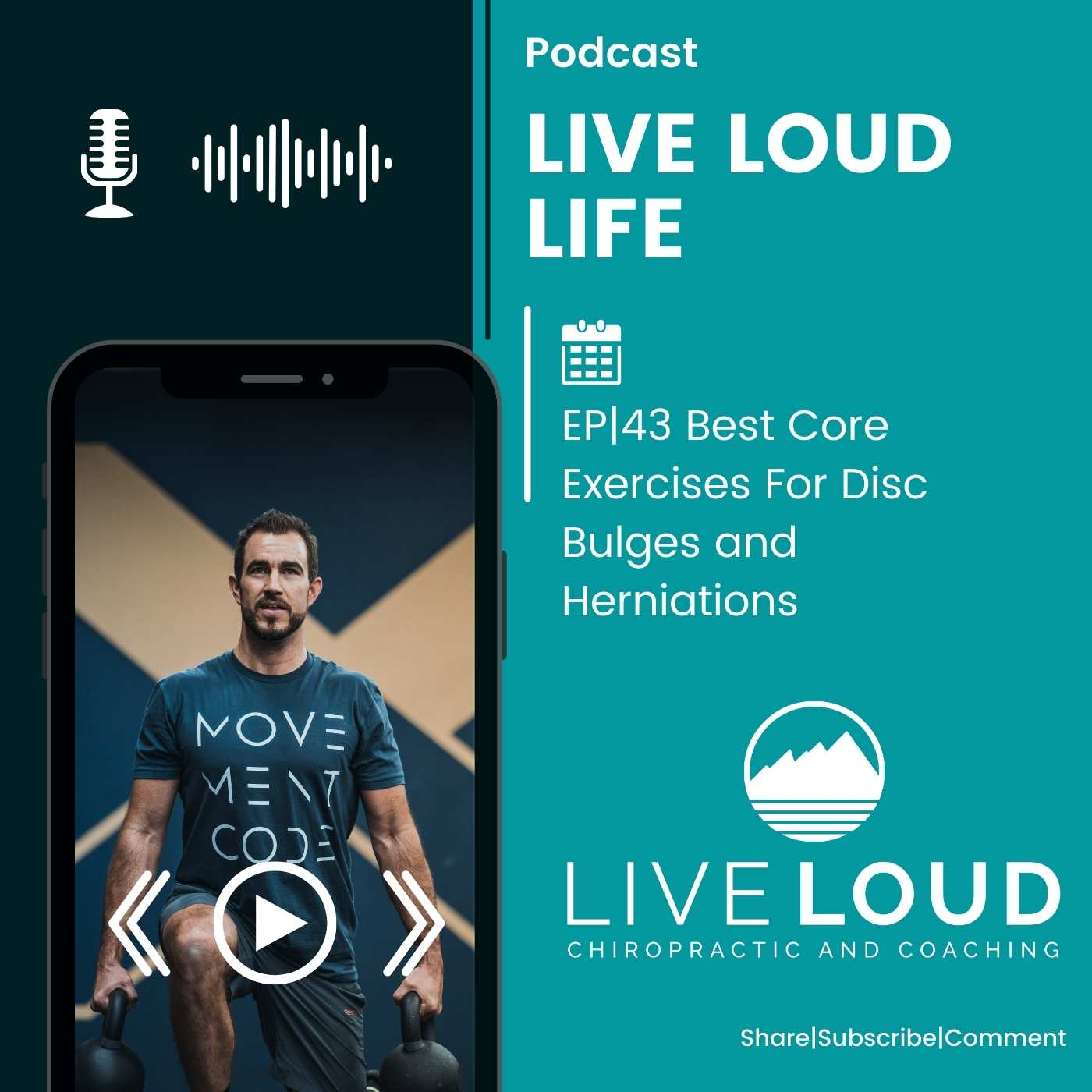Live LOUD Life PodcastLafayette Colorado
Episode 71
How to Choose Weight When Lifting or Training
With Dr. Antonio Gurule
Want to increase the weight you lift? Or the amount of reps you do? Whatever your goals are, Dr. Antonio has guidance for you.
Episode Highlights
3:00 – “How do I know what weights to use? / How many reps to do?”
5:00 – Tough at 10 method
7:30 – Goblet squat sample of building up weight or reps
15:00 – Discouraging from doing the same exact workout day after day
About Dr. Antonio Gurule

Background:
- Father
- Doctor of Chiropractic
- Owner of Live LOUD
- Personal Trainer & Health Coach
Check Out Some of Our Other Blog Posts and Podcast Episodes
Anthony Gurule 00:00
Hey what’s up guys, welcome back to another episode of the Live Loud Life podcast. My name is Dr. Antonio, your host of the Live Loud Life podcast. My wife and I, we own Live Loud Chiropractic and Coaching. We are based here in Lafayette, Colorado, which is in Boulder County and just north of Denver. So if you’re local, and you’re looking for some help, and you need a little bit of love, we’d love to help you guys out. If you’re not local, we do offer virtual consultations, where you know, we set up, set up a call where we help you workshop and work through some of the issues that you’re having.
Anthony Gurule 00:42
Our big philosophy is helping you and advocating for you to have an active role in your recovery. Many times we’re dealing with aches and pains or anything like that, it’s usually a more passive approach, meaning hey, you need to come in and get x y&z done, or I need to administer help you with these exercises. We believe that you need to understand how your body moves, how it operates, how to fuel it, so on and so forth. Now, yes, we are chiropractors, we do manual therapy, we do know the benefit of that. But if we can help feel fill the gap. For some of the information or knowledge that maybe you’re not getting from your other providers or practitioners, we’d love to do that oftentimes, these consultations are just you know, it’s almost as like a sounding board session, you we want to listen and hear what your goals are, and we kind of hear where you’re at, and we help you kind of just navigate and make some suggestions on how to get there. And that’s where we’re going with today.
Anthony Gurule 01:40
So today, one of the things that we have conversations around a lot is working out and training, right? This is exercise, fitness, you know, whatever you want to call it. This is obviously a big component of our life. And as you’ll commonly hear me say there’s seasons of life where things go up and down. And you know, it gets crazy, you know, from time to time depending what’s going on. But ultimately, we know and most people know that this is important. And we know that most people are trying to you know to accomplish this. And who this is for is, this is for a lot of people who are doing boot camps and different classes, especially online classes at home, or just you working out on your own, if you’re going to, you know, and this is more directed towards like the typical CrossFit class, right, their program is a lot more dialed in, right, where they’re kind of helping you navigate, hey, during this cycle, you know, we’re going to be building weights and the the rep schemes of the sets and reps of going up and down are obviously a lot more calculated and dialed. not to say that the boot camps and other ones are not, I’m not saying that. But for many of you, you’re working out at home, and it’s kind of like, Hey, I’ve been doing this workout for like the last five to 10 years. And it’s the same thing, it’s the same weight, it’s the same, right? And it could be providing everything that you need. So there’s nothing wrong with that. But one of the questions that we get is like, Well, how do I know like how much weight to use, or how many sets and reps to use? And so excuse me, I’m going to very, very briefly and kind of superficially give some of those recommendations.
Anthony Gurule 03:26
Now. There is a definite art and science to resistance training and weightlifting and everything that we’re talking about here. And if that’s you, and you’re interested in that this is not this is again, more of a superficial level. There’s definitely a ton of resources out there to to get that knowledge and information. But we kind of wanted to help you navigate like this overarching view, if you will.
Anthony Gurule 03:53
So when you’re looking at it, and this is not this is not going into program, or sorry, exercise selection and philosophy. We’re talking about adding weights, so on and so forth. And we’ll probably try to use like, you know, some specifics to just to create a little bit of context. But that being said, what we’re looking at here is how do you how to how do you know when we’re going to what weight to do? Now, If that’s your question, that usually indicates to us that the experience that you have weightlifting is probably a little bit less, and that’s fine. I’m not It’s not meant to be hurtful or anything but having that question indicates that we have not done a lot of lifting or time to know you know, what kind of how to how to manipulate and end that. and we were all there at some point. And finally, I don’t know do I go heavier? Do I not go heavier? What weight do I use?
Anthony Gurule 04:51
We try to start with Well, hey first, first and foremost, do you know how to do the movement? that’s important, right? Because if your know how to do the movement well and appropriately then adding weight’s not gonna be a concern. If you don’t know or you’re unsure, that’s where you would get a consultation, a trainer, whatever that is to determine how to do the movement appropriately so that we can add more load. Because if we’re adding more load, and we don’t know what we’re doing, that could be a recipe for possible injury. But most people start off with which again, for you, if listening to this, most people start off with something like three sets of 10, which is great, it’s a great starting point, really easy to understand and know.
Anthony Gurule 05:33
So what weight would you choose? Well, you know, if this is you’re just kind of coming back into something, obviously, you’re gonna err on the lighter side and just kind of go through the motions, which is fine. If you’ve been doing it for a while. And now you’re kind of at this point, hey, I want to try to add a little bit more. We want to look at tough at 10. Right? What Wait, could you do that feels tough at that 10th Rep? Now, not impossible, tough at 10 might be maybe three, maybe five reps in reserve, meaning after that 10th Rep, You only have a few reps in reserve. That’s a pretty good starting point to start eliciting some adaptation for strength, which is the reason why we’re doing weightlifting, right? So tough at 10 is a is a nice little starting point to determine what to do now you have a framework. Now you kind of have like a baseline. Right? Okay, cool.
Anthony Gurule 06:26
Well, we’ll just use an example. Let’s say we’re doing goblet squats, right? 25 pounds is tough at 10. And that’s, that’s, that’s now you have no you have a set and rep scheme, and you have a weight. And now we can play around with these numbers right? Now, ultimately, too we have to look back at what our goals are. Right? Again, in this situation? If this question is been asked more times than not, most people are saying I want to get a little bit stronger, I want to feel better. And I want to maintain some mobility, I want to tone up maybe a little bit, add a little muscle, lose a little fat, all those types of things right. Now, again, what’s great is if you are asking these questions, and we maybe weren’t doing as much before, anything we do will help you reach those goals. If you have been doing the exact same thing for years. Well, anything we do differently will help you achieve those goals. Because we’re now mixing it up. Right? We’re, we’re forcing the body to change and adapt because we’ve created this novel stimulus that it’s not used to and it will start to change, right. And that’s part of what we’re trying to do is add some things, take some things away, go a little heavier, go a little lighter.
Anthony Gurule 07:38
It’s this constant variable of kind of manipulations that really starts to challenge the body multiple different ways. And that’s the beauty behind it. Right?
Anthony Gurule 07:48
So coming back and trying again, stay as somewhat specific as we can that make things complicated, right? We have a goblet squat, we have three sets of 10. And we got 25 pounds, okay, so we’re going to be running that for, you know, maybe a couple of one to two weeks, a couple times a week, so on and so forth. So now that you’re starting to feel you’re like, Okay, well, 25 pounds, starting to feel a little easier, starting to feel a little bit lighter, wonderful, we can start to take that up a little bit, right, let’s go. If you’re doing dumbbells and go to 27 and a half, you can go to 30 pounds, okay? Now, what most do in this situation, we remain at three sets of 10 and just start adding more weight. Not wrong, but what you’re going to find is you’re going to very quickly cap out, right, because you’re doing the exact same amount of volume with heavier loads. And that’s much harder for your body to adapt and handle. So what we, you know, typically suggest trying as you’re doing this, and it really just depends on the, the, how big of a weight jump, you know, you make. Let’s say for instance, you went from 25 to 35, three sets of 10. With that, what’s quick math on that, right? It’s, it’s a nearly a third, it’s a little bit more than like a third 30, 33% increase, it’s more than a third of an increase. That’s a big jump in weight, and you’re doing the exact same three sets of 10. Now, being that it’s still kind of in a lighter load, if you will, depending on the person, obviously, you might be able to accomplish that fine, but for someone else, that might just be way too much.
Anthony Gurule 09:28
But yet that next jump up if they only had that 25 to 35 upon options, what do you do? Well, you manipulate the sets and reps, right? So we were doing three sets of 10. If 35 If the 10 pound jump is is really really heavy and big. But yet you can do some well, we might say hey, let’s start three sets of three. So we significantly dropped down how many reps you’re doing from 10 to three, which allows you to do the heavier weight right the heavier weight to be able to complete it with proficiency and safety, so on and so forth. So that would be a valid option to allow you to choose a heavier weight, we’re just going to start to manipulate the sets and reps.
Anthony Gurule 10:11
Now, what you could also see… how this could also play out is let’s say for instance, you have like a medium, heavy, and light day, throughout the week. So we’re doing goblet squat three days a week, we have a medium day, a heavy day, and a light day. So you know, your heavy might be 35 pounds, your medium might be 25 pounds. And then your light might be, let’s just say 15 pounds, right.
Anthony Gurule 10:32
So you might be doing like five sets of 10 for the light, three sets of 10 with a medium and three sets of three with the heavy, right, three sets of three reps. So you’ll see how the volume for each one of those obviously changes based on the weight that you’re using. Now, again, all this kind of comes has come back to the goals, but based on the goals that we set, right, get stronger, add some muscle, lose some fat, tone up a little bit, maintain mobility, that would work really well for what that person is trying to accomplish. without a lot of complexity, right. And it allows you to stay consistent. And consistency really is your key when you’re looking back for completing all these things.
Anthony Gurule 11:16
What helps you complete the most amount of work throughout the week, consistently, week after week, month after month, year after year, right? While still mixing it up. Because again, we’re trying to get out of the mode of hey, I’ve been doing, you know the exact same workout where I hit shoulders, back legs, so on and so forth. I you know, I got my weights dialed in, I do three sets, three sets of 10 of everything. And or, you know, honestly, for most people, it’s, I just, I just go until I can’t do anymore, I blast it and then I just cycled through so on and so forth. Nothing wrong with that, you know, different goals, perhaps, but just that’s what we’re trying to say. So now, again, that was kind of that first initial thing to at least get us a starting point of how to add weight and change weights. So the three sets of 10 or tough at tens, a really good place to start. This could be no different. If we’re talking about pressing, if we’re talking about like TRX rows. If we’re talking about deadlifts, lunges, you know, that’s a good good place to start.
Anthony Gurule 12:16
Now, as a side note, when we’re talking about certain levels of strength, right, we’re talking about getting stronger, there’s there’s different elements of strength that I want you to kind of take in consideration, because when you look at like, let’s say, like a bodybuilder, obviously strong. And they’re oftentimes doing these failure sets, you know, high rep, lighter weights, where you’re going to a lot of pomp, and a lot of fatigue, to elicit a certain adaptation for hypertrophy and growth, and also strength. But you can’t do that with heavy weights, right. So the heavier weights, as we were saying, We’re doing three sets of three. So when you’re looking at strength development, which will come with some muscle building and hypertrophy, but a lot of that strength development is from a neural component, that neuro muscular relationship is really being enhanced through that. And from a fatigue standpoint, to elicit being stronger, you have to lift heavier weights. And in doing so you can’t do those three to five sets of 10+, 10 12,15 reps, or whatever it is. you’re more likely going to be staying in, you know, three, maybe five sets with three to no more than really five reps. So a five by five set, that’s still 25 total reps of work. And you’ll be able to do a heavy weight with that. And it really just kind of depends on how its programming, you know, put into play with how much rest. But when oftentimes, when you’re looking at doing like deadlifts, and squats, and these bigger compound movements, where you’re adding a ton of weight, and you’re trying to lift heavier weight, right, you might only be doing no more than 10 total reps.
Anthony Gurule 14:04
So that might be a three by three, which is nine reps, five by two, which is 10 reps, right? Or you could just go 10 sets of one, you see what we’re saying here? But if you’re if you’re doing that, without a heavy enough weight, you’re not going to really most likely be eliciting the adaptation that you’re looking for.
Anthony Gurule 14:23
So again, coming back to the person here listening to this and unsure that’s probably not going to be where you’re at. But notice it did come into play when we were talking about having a light, medium and heavy day. Right? Because again, often times we’re not hitting that kind of edge and we’re seeing that the comfortable weight which is which is completely valid and fine if you’re newer and you’re still trying to just figure out exercise technique and everything like that. But if you’re the person who’s been doing this, and I got, obviously someone in mind here, been doing the exact same workout for 10 years and nothing’s changed, you’ve increased weight, obviously, when we’re when we’re mixing it up here, going heavier, heavier than what you were doing, we’re going to drop those sets and reps to not hurt the body and overstress it so on and so forth.
Anthony Gurule 15:15
So, congratulations, taking this next step of trying to figure out, hey, what do I need to do to get stronger? Well, we know we need to lift some weights. I don’t I don’t, I don’t know what movements, I don’t know how many sets, I don’t know how many reps, I don’t know what weight to choose. So you got to start playing around. Now I will add, getting a trainer, getting a coach, doing a consultation, something that helps you get a starting point. it helps with a lot of the kind of uncertainty and starting off. And that might just save you some time and effort. Not that you have to go with someone that has like a very, very long program. But oftentimes just finding someone who’s like, hey, I need you to help me just kind of get going. That’s a great place to start. And then you can kind of take off from there.
Anthony Gurule 15:59
I hope this was helpful. This is again, the approach that I took years ago, as I was starting to get into weightlifting. I had some people that I was helping out. I was I was following someone, that’s also super beneficial. Have a buddy, a buddy who’s been doing it. But you know, I like exploring and trying to learn things on my own so I’d watch videos on technique, exercise selection, so on and so forth. I practice the movement, film myself, watch those videos side to side, compare and see how you know it’s playing and working out, and then and then practice the movements, see if I’m able to lift more? did I create any injuries or sore spots where it shouldn’t be? And then I would just kind of play with those.
Anthony Gurule 16:37
And then as I started to learn more and more, then I started to change the weights and the weights and the rep schemes based on my goals, based on all the research that’s out there on exercise Science, right. there’s a lot of people put a ton of effort in on how to elicit the best response that you want. But again, if you’re the at home Doer who’s just looking to maintain this this level of health and fitness and get a little stronge,r little tones, a little bit of fat, this is a way to do it, push, pull, hinge, squat, carry. you know, add some light days at some medium days, add some heavy days, get outside walk, drink water. you know, it doesn’t take rocket science here.
Anthony Gurule 17:21
But oftentimes that first hurdle of exercise or sorry, choosing the right weight in the rep scheme can seem very daunting if you have not done a lot of it. So hopefully this helps you get kick started a little bit and at least point you in the right direction to hopefully get some momentum, but do not hesitate to reach out for help it it really, it really saves you a lot of time, money and effort in the long run, just getting a little bit of guidance and direction if you feel like you keep hitting these roadblocks, or speed bumps that are that are significantly slowing you down.
Anthony Gurule 17:52
So happy lifting. Thanks for tuning in guys. Please make sure to like, share, and subscribe if you’re diggin the content. And if you have any special requests for topics to chat about, or any exercises you want us to workshop or break down or go through we’d love to love to hear that so we can make this as applicable to you and the things that you have going on. So till next time, guys, live loud.
–




